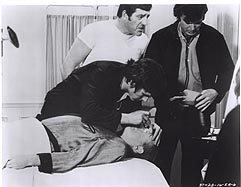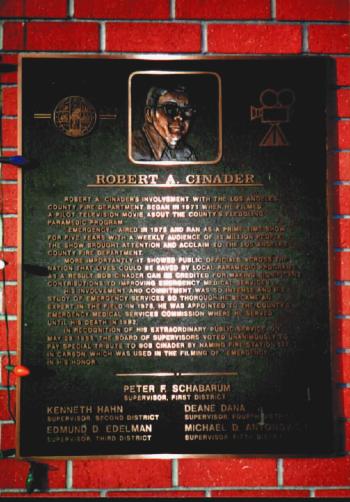

Revised 10.08.01
Air Date: January 15, 1972
End Date: September 3, 1977 (last 2 hour movie televised July 6, 1979)
Time Slot: Saturdays, 8:00 PM EST on NBC
Executive Producer: Jack Webb (until 1973) and R.A. Cinader
Created by: Harold Jack Bloom and R. A. Cinader
Producer: Edwin Self and others from episode to episode
Associate Producer: William Stark, (from 1973) Gino Grimaldi, Hannah Shearer and others from episode to episode
Directors: Jack Webb (pilot), Randolph Mantooth, Kevin Tighe, Dennis Donnelly, Preston Wood, and others
Produced by Mark VII Productions for Universal/MCA
The television series first aired on January 15, 1972. It was a two-hour episode detailing the genesis of the paramedic program and the passage of paramedic legislation (Actually Wedworth-Townshend, the law allowing paramedics, passed in 1970). The station, #10, at the beginning of the pilot was actually Station 8 in West Hollywood. The first one-hour show on January 22 introduced Boots, the station dog and featured a helicopter rescue in the mountains. The series went on hiatus from July to September 1972.

Again, in the late summer of 1973 the show was stilled except for one episode. The series ended in 1977 and two hour episodes were aired periodically until 1979.
This time slot posed a problem as the show began while Archie Bunker broke ground with his bigoted and childish rantings. The last half hour, consequently, had the major rescues take place when " All in the Family" went off the air.
Jack Webb was the executive producer but for the most part Bob Cinader ran the show. Cinader and Harold Jack Bloom sought to create a show similar to "The Hellfighters", a John Wayne movie about oil well firefighters. Later the paramedic program was fitted into the plot. The show had numerous directors and writers, including Randolph Mantooth and Michael Norell (who was a screenwriter prior to becoming Captain Stanley).
The series began in 1969-70 when Sid Sheinberg, president of Universal TV, felt a "variant of that action-packed realism" in "The Hellfighters" (a 1969 Universal movie based on oil fire fighters starring John Wayne) would be just the thing for early evening television. According to Turow's 1989 book "Playing Doctor"(1989; Oxford Press) this was "the direct spark for the series".
Sheinberg went to Jack Webb with this and asked him to consider developing a series with Universal about a firefighter rescue team.
Squad 51 in 1976
Jack Webb was chosen as "Dragnet" contained its share of action and realism and because of "Adam-12" a Webb show that kids a nd grownups loved. He asked "Adam-12" creator Robert Cinader to go over the concept. Cinader ruled out wouldwide firefighting and found that the "Los Angeles fire department" upon his investigation embarked on a trial program using paramedics.
Cinader found the elements Sheinberg wanted. He envisioned two elements; two paramedics and the firemen they worked with. The second would be the hospital they delivered the patients to. According to Turow, "It was a required aspect of the show but Cinader saw it as secondary to the main drama out in the field."
This was contrary to what Jack Webb wanted. He wanted the hospital to be central. He cast his former wife, Julie London; and Bobby Troup, her husband, as players at the hospital. Webb had Harold Jack Bloom and Bob Cinader's pilot rewritten to reflect the struggle of the Rampart General Hospital group to get the state legislature to legalize paramedics. Gage and DeSoto were reduced to support characters.
Jack Webb had irked the Los Angeles County government by not featuring their sheriff's department in a show he was producing and the county fire department, unlike the city's fire department ambulance service, did more than scoop and run. It did some interesting rescue work. Therefore Webb chose the Los Angeles County Fire Department and enlisted the aid of Battalion Chief Jim Page. He and Chief Page went to NBC executives in the fall of 1971 and shot the pilot later that year.
Webb lost control of the show afterwards and the fire-rescue action figured as primary to the plot. Viewers of the first season will notice that Roy henpecks Johnny and Brackett is a hard-nosed ogre. This is due to Jack Webb's influence on the show. Webb believed in realism and staid professionalism in his productions. Bob Cinader took control of the show after the pilot and mellowed everyone into more likeable characters.
Most indoor shots were filmed on a sound stage while stock footage of Station 127 depicted the squad and engine rolling on a call. Rampart General Hospital never existed. The actual hospital was Harbor General Hospital in Torrance, California where exterior shots were done. In fact it was on the same street as Station 127. Mention is made of Station and Truck 127 as well as Station 36. Bob Cinader rode on a squad to learn the EMS trade before the show was shot. There is a Truck 127 at the Carson station. In 1985 a plaque was erected at Station 127 to honor Cinader
 Plaque honoring Bob Cinader at Station
127. Courtesy Paul Ross, FF/EMT.
Plaque honoring Bob Cinader at Station
127. Courtesy Paul Ross, FF/EMT.
The squad used was at first an actual fire department vehicle but the studio bought a similar rig which had a few successors over the years of the show. Engine 51 was at first Engine 60, a 1965 Crown FireCoach with a Hall-Scott gasoline (yes, the clear stuff!) engine. Ward Lafrance, a famous fire equipment maker, donated a rig in 1973 to Universal with the understanding it would be sent to the fire department upon the show's cancellation. Before the shooting for the 1973-4 season i t did a coast-to-coast tour with Stoker at the wheel. It is fighting fires at Yosemite and will be sent to the Los Angeles County Fire Museum when its service is over.
 Photo courtesy The Gern
Photo courtesy The Gern
The show stood out as being the most realistic of the firefighter/EMS shows. This was in no small part due to Jack Webb's zest for realism (even if tinged by the lack of office politics and infighting that are part of public safety. Dennis Smith's "Report from Engine Company 82" book depicts the down side of public services). A real live Los Angeles County paramedic, Bob McCullough, worked as technical advisor. Randolph Mantooth even took an EMT course. Ron Pinkard was a pre-med student before he went to Hollywood.
Hannah Shearer, a co-producer, said, "Bob's theory was, you can teach through entertainment." without them knowing they were being educated.(Turow)
Critic's Corner
The early years represented the best, most interesting episodes of the show. Later shows got into more mundane aspects. A recurring theme Webb hit on, which many may not think is important, was the need for adequate prehospital care. Some episodes took this to full extent, with one show focusing on whether or not the fire engine had emergency medical gear.
Put into the usual scheme of television plots and conflicts it seems insignificant. "St. Elsewhere" and other Eighties and Nineties medic shows seemed focused on more everyday and universal conflicts we could all feel. But none of the soap opera content seen in most medical shows existed in "Emergency!"
Partly this was due to the Mark VII Productions executive producer, Jack Webb and his idealistic view of public servants. Robert A. Cinader (Adam-12, Dragnet) and Harold Jack Bloom, with then-Battalion Chief Jim Page of the Los Angeles County Fire Department; midwifed the show. Original plans sought to make it into a show based on "The Hellfighters"
Jack Webb wanted to make the show more of a medical format. If he succeeded, who knows, maybe an older demographic would have felt warmer to the series. Then again it would have been another medical show competing with "Marcus Welby, MD" and "Medical Center" had Webb got his way. Bob Cinader had a bit more control over this Webb production than with the other Mark VII shows and took medicine to the streets. The first season was mostly a medical drama but as time wore on the firemen seemed to be the drawing card so Cinader capitalized on this.
Critics panned the show and viewed it as a collection of news clips of explosions and other disasters. Maybe it wasn't exactly Emmy material. Even if it did not measure up to "Marcus Welby" and "St. Elsewhere", to say the show served no purpose other than that of publicity vehicle and kiddie show is unfair. The show did attract some important fans. The late Senator Alan Cranston of California thanked Jack Webb for helping get EMS legislation passed. (Question; was Alan Cranston referring to the "Snakebite" episode of "Emergency!" and the 1973 EMS Act? ANSWER (4/1/01)See Sherri's press releases at emergencyfans.com) More importantly, Richard Nixon himself watched the show and this resulted in numerous changes in the federal government's role in fire safety.
Besides, the Emmy winning show for Best Drama in 1972 was "Elizabeth R". Like anyone cares!